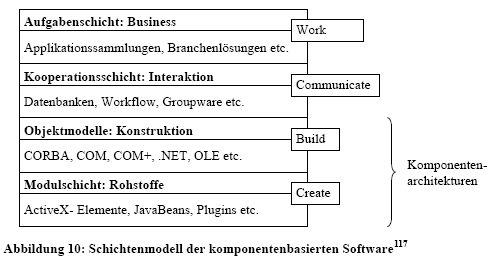Component architectures are the heart of the computer family development, because they assemble the "raw materials" systematically. The connections are here graphically represented:

Component architectures are presented in the following. Differences becomes thereby between single place systems such as COM, and architectures for distributed, heterogeneous systems like e.g. CORBA.
COM is the object-oriented component model of Microsoft. The origin of COM lies in the technology of the group documents OLE introduced to the 1990ern, with which partial documents are embedded into other documents. Philosophy is here that applications make functions available, which also different programs can be from use.
So Word must e.g. know, how it must represent an integrated Exceltabelle. This means a re-use from program code already existing and This re-use of components.
Data exchange takes place in the Client/server model: The COM server produces and uses objects and offers the classes which can be exported, the COM objects, over the interfaces.
In the interfaces is deposited the information, which functions are offered.
The use of the functions takes place by pointers on one or more interfaces a component. The interface possesses a pointer on its internal table, which administers the pointers on its functions. It can be never accessed directly objects.
Transmission is possible here however only with the characteristics of the interfaces.
Interfaces have thereby a world-wide clear GUID, which must be registered before the use of the component into the Windows Registry. By the clear identification over the GUID components know also the same name carry118.
Components are present here as binary standard and are programming language independent thereby, the specification of the interfaces contain no special syntax, but describe the structure and the offered services of components. Besides 1996 a further model, the DCOM for distributed applications in the network were created. Today Microsoft COM+119 develops as an extension and the .NET-Frameworks120, which will replace some problems of COM to improve to be supposed and according to Microsoft COM.
COM components become as modules in the form of applications (as EXE on the local server with slower execution), as DLLs and OCX (in-process and This fast constantly)
or as Windows Script Components delivered121. Since 1996 there are also COM components, which were created particularly for
Internet: ActiveX of control members. They have only one interface and the ability to register itself automatically into the Windows Registry.
Such control members are installed firmly thereby on the Client, which brings substantial safety problems with itself, since so the which is the basis operating
system lies openly.
The architecture of COM can be evaluated as follows:
| Evaluation of the COM-Architecture122 |
| Advantages | Disadvantages |
|
|
- 117: See [point 1999] P. 21
- 118: See [Balz 2001] P. 871 FF
- 119: COM+ is belonged a platform and a model for the Clientseite, available in binary form, in one, and propritär to Windows. See [Balz] P. 941
- 120: See [build 2000] P. 53
- 121: See [Schw 2005]
- 121: See [Schw 2005], [Balz 2001] P. 896, [Micr 2005], [point 1999] P. 19 FF and [Punz 1999]